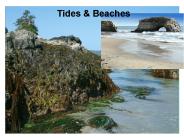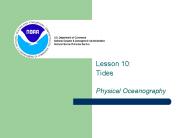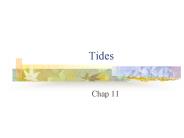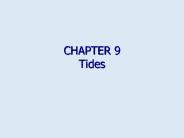Tide PowerPoint PPT Presentations
All Time
Recommended
close to a source of gravitation. through differential acceleration ... Saturn. Uranus. Neptune. R_p. 2R_p. 3R_p =satellite. rings. 0. Roche limit is somewhere ...
| PowerPoint PPT presentation | free to view
(Role of sun: next ) Role of the earth's rotation. Effect of the sun ... (upper zone): exposed to air more than water, but submerged at least 1x per day ...
| PowerPoint PPT presentation | free to view
Tides and Tidal Forces Near Satellites Orbit Faster What If Satellites Are Tethered? The Tension Is Real There are Two Tidal Bulges on Earth Both Moon and Sun Cause ...
| PowerPoint PPT presentation | free to view
Tides and Tide Raising Forces
| PowerPoint PPT presentation | free to view
However, centrifugal force gets stronger as the radius of rotation increases ... G1 G2 G3 and C1 C2 C3, where G= gravitational force and C= centrifugal force. ...
| PowerPoint PPT presentation | free to view
Spring tide variability is more semidiurnal, neap tide variability is more diurnal
| PowerPoint PPT presentation | free to view
Ancient & Renaissance Western Civilization. Words and ideas belong to an ... 58.3% of high school students let someone else copy their work in 1969, and 97.5 ...
| PowerPoint PPT presentation | free to view
Tides Tides Tides are caused by the gravitational pull of the moon, sun and by the rotation of the earth, moon and sun. Tidal Cycle Tidal cycle Because the moon ...
| PowerPoint PPT presentation | free to download
Tides 1. Tides-What are they? Tides Tides are the regular rise and fall of ocean water levels. 2. What causes tides to occur? Tides are due to the gravity of the moon ...
| PowerPoint PPT presentation | free to view
Tides Essential Question: What causes tides in the oceans? What are Tides? The daily rise and fall of Earth s waters on its coastlines are called tides.
| PowerPoint PPT presentation | free to view
Tides Objective How do the positions of the Earth and Sun effect the four seasons? Summer Solstice The longest amount of day light and the shortest night.
| PowerPoint PPT presentation | free to view
TIDES What are tides? The periodic rise and fall of the sea level under the gravitational pull of the moon Tides are one of the most reliable phenomena in the world.
| PowerPoint PPT presentation | free to view
TIDES periodic, short term changes in the height of the ocean surface at a particular place * Figure 10.2 A planet orbits the sun in balance between gravity and inertia.
| PowerPoint PPT presentation | free to view
Supreme Allied Commander Transformation Technology for Information, Decision and Execution superiority TIDE Network Enabling the Alliance and its partners through ...
| PowerPoint PPT presentation | free to view
Tides Tides are Periodic, short-term changes in height of the sea surface Caused by gravitational forces The longest of all waves Always shallow water waves Forced ...
| PowerPoint PPT presentation | free to download
Tides * * Gravity Remember, that gravity is an invisible force of attraction between two objects. What celestial object is attracted to the Earth?
| PowerPoint PPT presentation | free to download
Tides & Seasons - Winston-Salem/Forsyth County Schools ... Tides
| PowerPoint PPT presentation | free to download
Title: PowerPoint Presentation Author: Stacy - McGraw-Hill Higher Education Last modified by: TYLER JOHNSON Created Date: 11/7/2002 3:12:30 PM Document presentation ...
| PowerPoint PPT presentation | free to download
Therefore the moon has a greater effect on the tides due to its proximity Gravity, Inertia, and the Two Bulges Two tidal bulges (high tides) ...
| PowerPoint PPT presentation | free to view
Eclipses Since the Earth and moon are not self-luminous (don t create their own light), they cast a shadow Eclipse: When a celestial object fully or partially moves ...
| PowerPoint PPT presentation | free to download
Title: PowerPoint Presentation Author: Al Trujillo Last modified by: aisd Created Date: 7/13/2001 4:34:54 PM Document presentation format: On-screen Show (4:3)
| PowerPoint PPT presentation | free to download
moon and is 390 times farther away. the centripetal ... full moon. new moon. earth. earth. 3rd quarter moon. Neap Tide. earth. 1st quarter moon. Tidal Patterns ...
| PowerPoint PPT presentation | free to download
Semidiurnal two high, two low each day (most common) Mixed semidiurnal successive high tides of different heights (most of U.S. west coast) ...
| PowerPoint PPT presentation | free to download
TIDES WATER CYCLE OCEAN FLOOR CURRENTS AND WATER WAVES END OF GAME Daily Doubles and usage notes follow... JEOPARDY! Slide Show Notes The font for the question ...
| PowerPoint PPT presentation | free to download
Tides Presented to: Sir Mehtab Ahmad Presented by: Group(A) Roll No 6151, 6152, 6153, 6154, 6155, M.Sc Geography. 1st Semester Contents Definition Causes Theories ...
| PowerPoint PPT presentation | free to download
The tide rises when coastline enters the bulge and falls when it rotates out High tide * Different types of tide Sun Earth Moon Spring tides occur when the sun and ...
| PowerPoint PPT presentation | free to download
Tides Chap 11 * * * * * * * * * Tides Tides in the eastern Bay of Fundy on the Atlantic coast of Canada. (f.11.31) Tidal range is 15 meters (50 feet).
| PowerPoint PPT presentation | free to download
TIDES Definition Tides = periodic rise and fall of large bodies of water Caused by the gravitational interactions between the Earth and the Moon and the Sun Lunar ...
| PowerPoint PPT presentation | free to view
Slack Tide not changing. The moon's gravity pulls on the Earth ... ( It has nothing to do with the season 'Spring'.) NEW MOON ...
| PowerPoint PPT presentation | free to view
Does not consider the effects of continents, ocean basin shape and ocean depth ... Now considers ocean depth, continents, the shape of the basin AND what that ...
| PowerPoint PPT presentation | free to view
3) But then why is the sun's once a day tide bigger in some. oceans? Synthesis: In really small oceans, like the Mediterranean, even the twice a day ... Why? ...
| PowerPoint PPT presentation | free to download
Typically, the Roche Limit lies. at a distance of 2.4 planetary ... All major ring systems lie within their respective Roche limits. Comet Shoemaker-Levy 9 ...
| PowerPoint PPT presentation | free to view
Section 13 - 2 Tides EQ: What causes tides? iRespond Question Master A.) Response A B.) Response B C.) Response C D.) Response D E.) Response E Percent Complete 100% ...
| PowerPoint PPT presentation | free to download
When the tidal range is big and convergence is rapid, a tidal bore can develop. ... Tides occur as Earth rotates beneath the bulges. ...
| PowerPoint PPT presentation | free to view
Angular distance of Moon or Sun above or below Earth's equator (declination) ... Tide every 6 hours at 28 N latitude when declination of Moon is 28 N ...
| PowerPoint PPT presentation | free to view
land and is produced by the balance between the gravitational ... hydrography. may alter speed, produce resonance effects and seiching, storm surges ...
| PowerPoint PPT presentation | free to view
Title: Tides Author: Doug McClure Last modified by: Doug McClure Created Date: 10/14/2005 2:52:23 AM Document presentation format: On-screen Show Company
| PowerPoint PPT presentation | free to view
Since the earth is big object, the gravitational forces fails to deform the earth (much) ... moon work at right angles, causing the bulges to cancel each other. ...
| PowerPoint PPT presentation | free to view
More precisely, the Earth and Moon, and the Earth and Sun ... Seaside, 12th Avenue bridge, Necanicum River. Brookings, Chetco Cove. Wedderburn, Rogue River ...
| PowerPoint PPT presentation | free to view
The monthly tidal cycle (29 days) About every 7 days, Earth alternates between: Spring tide Alignment of Earth-Moon-Sun system (syzygy) Lunar and solar bulges ...
| PowerPoint PPT presentation | free to view
... Sun pull water toward themselves, causing bulges of water on the near and far ... More precisely, the Earth and Moon, and the Earth and Sun rotate around ...
| PowerPoint PPT presentation | free to view
This other bulge is the result of both the Earth and ... Earth and Moon rotate around this same axis (If they did not, then the unbalanced force of. the Moon ...
| PowerPoint PPT presentation | free to view
Sun Earth Moon Solar Eclipse Solar Eclipse Lunar Eclipse Lunar Eclipse . Title: The Tides & Eclipses Author: ASA Last modified by: Kristina Menissian Created Date:
| PowerPoint PPT presentation | free to download
Ocean Tides Tides The tides on Earth are created by the gravitational pull of the moon and the sun on the Earth. The moon is much closer to the Earth than the sun ...
| PowerPoint PPT presentation | free to view
Red Tides Analysis of possible regulatory motifs Fe2+/Zn2+ uptake regulation proteins (FUR) Upstream sequences of orthologs with similar motifs What can we conclude ...
| PowerPoint PPT presentation | free to download
Tides and Seasons Spring Tides Occur every month during the new and full moon. Highest high tides. Neap Tides Occur every month during the first and third quarter moons.
| PowerPoint PPT presentation | free to view
CHAPTER 9 Tides Coastal tidal currents Whirlpool Rapidly spinning seawater Restricted channel connecting two basins with different tidal cycles Fig. 9.19 Tides and ...
| PowerPoint PPT presentation | free to download
Auburn's National Championships. 1957. The Million Dollar Band! Roll Tide! I love alabama ! Good Luck to You on November 18th! I've got my eye on you! ...
| PowerPoint PPT presentation | free to view
Title: Chapter 24 Section 3 The Ford and Carter Years Author: Kevin Hammer Last modified by: NPSD Created Date: 8/2/2005 6:01:58 PM Document presentation format
| PowerPoint PPT presentation | free to view
Topic 4 What are tides? Tides are cyclic rises and falls of ocean water. The cycle takes about 24 hours and 50 minutes Ocean tides occur 4 times a day: 2 highs and 2 ...
| PowerPoint PPT presentation | free to view
... hundreds of tube feet under each arm. Each foot has a suction cup ... If it loses an arm it will grow a new one. Hermit Crab. A hermit crab lives in a shell. ...
| PowerPoint PPT presentation | free to view
Ratio of net littoral drift to maximum discharge through inlet. r = MNET/QMAY ... An Inlet System Showing Diversion of Littoral Drift. Types of Ebb Tidal Deltas ...
| PowerPoint PPT presentation | free to view
Title: INTRODUCTION TO GENERAL OCEANOGRAPHY (GEOL 1033X2) Author: Barry Computer Centre Last modified by: cameron Created Date: 11/10/1996 2:09:52 AM
| PowerPoint PPT presentation | free to view
Title: PowerPoint Presentation Author: jmeyer Last modified by: Liebeck, Jeff Created Date: 12/21/2003 6:56:17 PM Document presentation format: On-screen Show (4:3)
| PowerPoint PPT presentation | free to download
What about accepting this idea: force, ... Every particle in universe attracts every other particle with a force that is ... Gravitational Field Inside of Planet ...
| PowerPoint PPT presentation | free to download
Tides and Currents
| PowerPoint PPT presentation | free to view
























































